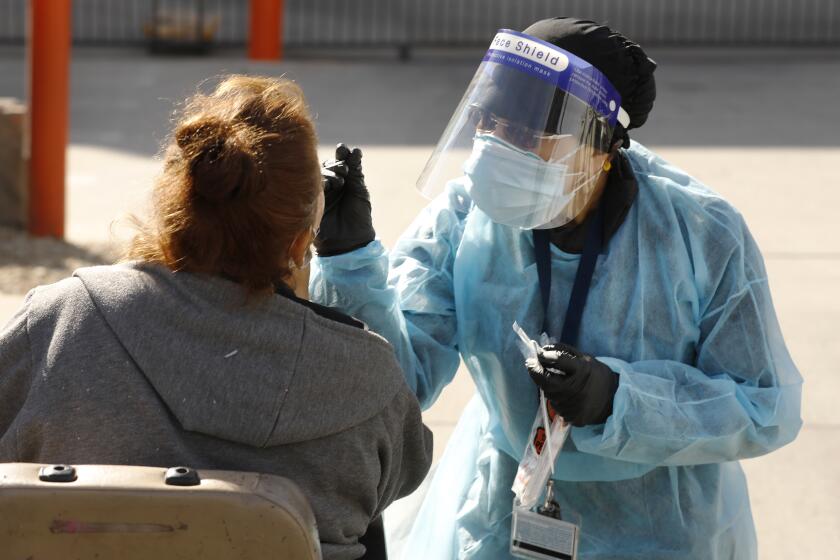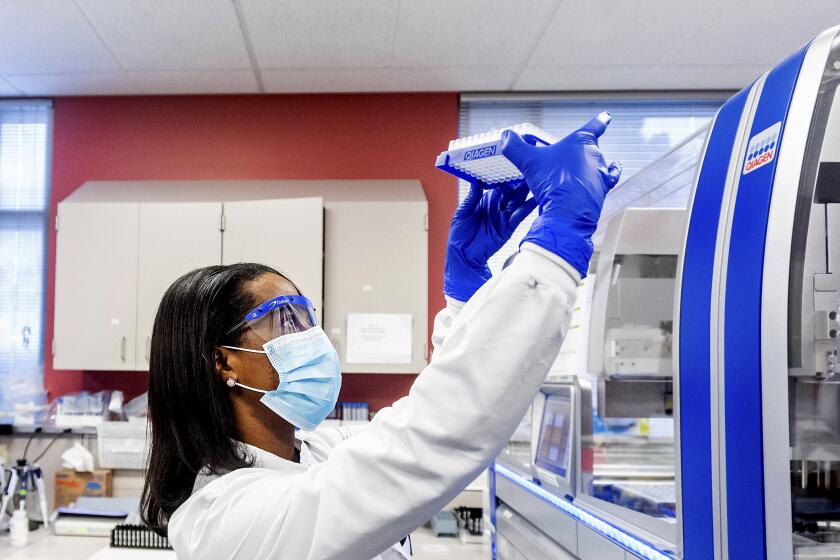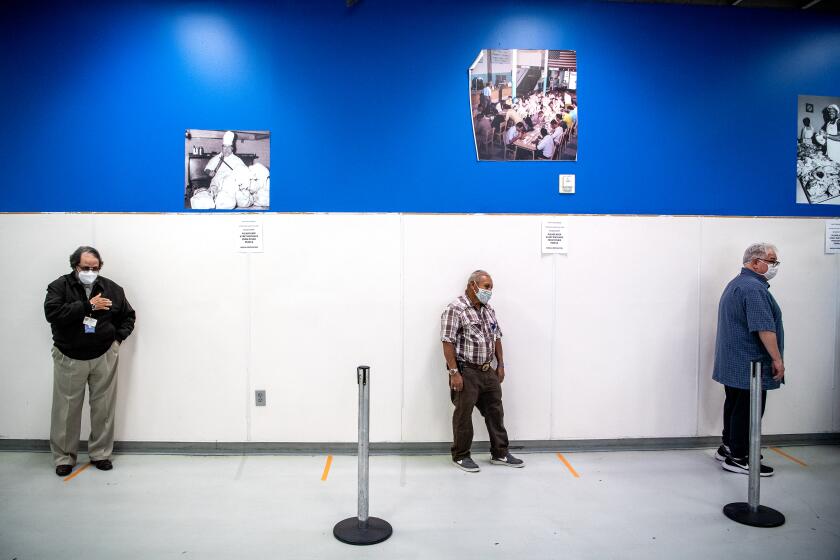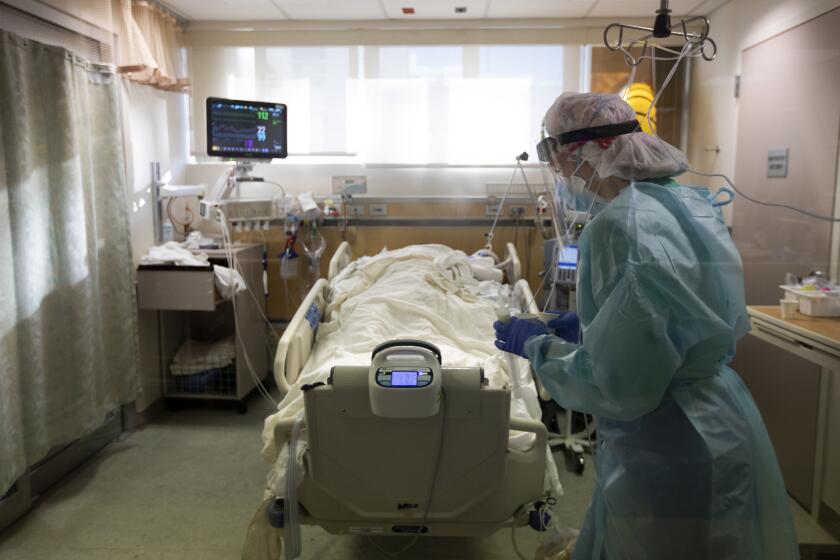Californiaâs coronavirus strain looks increasingly dangerous: âThe devil is already hereâ
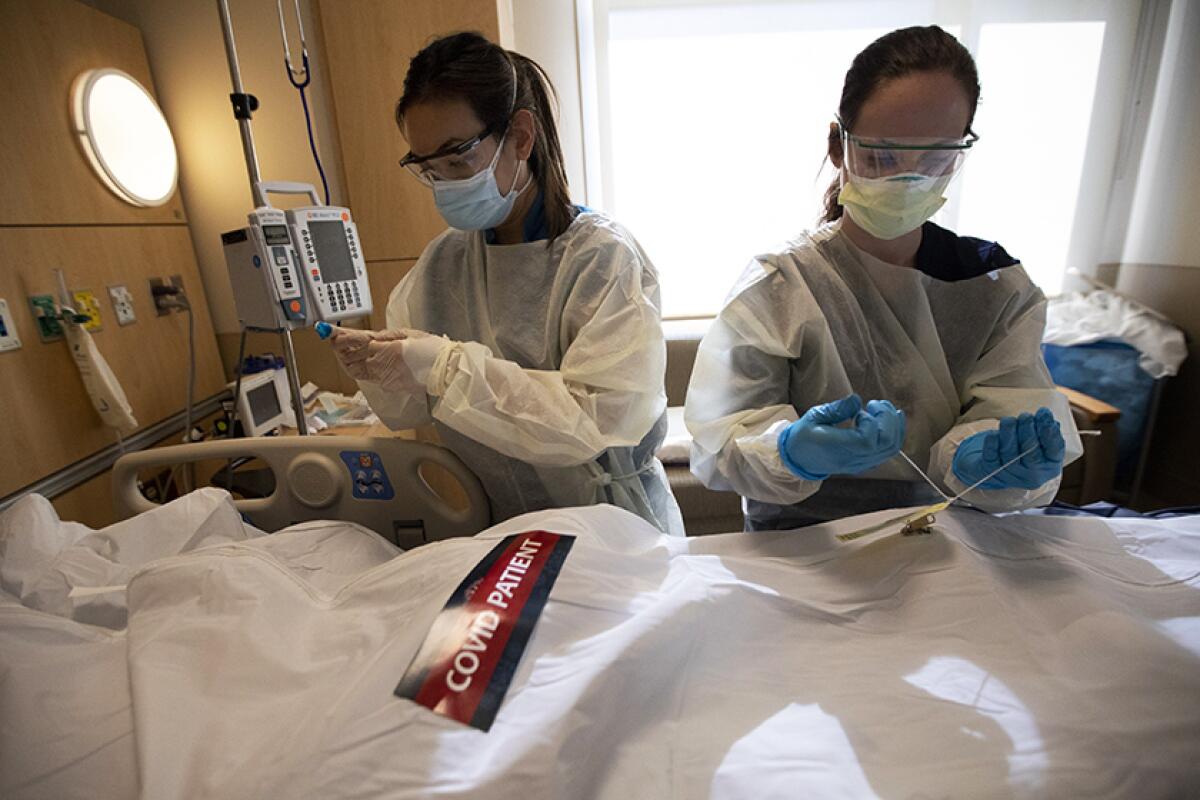
A coronavirus variant that probably emerged in May and surged to become the dominant strain in California not only spreads more readily than its predecessors but also evades antibodies generated by COVID-19 vaccines or prior infection and is associated with severe illness and death, researchers said.
In a study that helps explain the stateâs dramatic holiday surge in COVID-19 cases and deaths â and portends further trouble ahead â scientists at UC San Francisco said the cluster of mutations that characterizes the homegrown strain should mark it as a âvariant of concernâ on par with those from the United Kingdom, South Africa and Brazil.
Californians, along with the rest of the country, have been bracing for an onslaught of the more transmissible strain from the U.K. known as B.1.1.7. But they should know that a rival strain that is probably just as worrisome has already settled in, and will probably account for 90% of the stateâs infections by the end of next month, said Dr. Charles Chiu, an infectious diseases researcher and physician at UCSF.
âThe devil is already here,â said Chiu, who led a team of geneticists, epidemiologists, statisticians and other scientists in a wide-ranging analysis of the new variant, which they call B.1.427/B.1.429. âI wish it were different. But the science is the science.â
The U.K. and California variants are each armed with enhanced capabilities, and the likelihood that they could circulate in the same population raises the specter of a return to spiking infections and deaths, Chiu said. It also opens the door to a ânightmare scenarioâ: That the two viruses will meet in a single person, swap their mutations and create an even more dangerous strain of the SARS-CoV-2 virus.
The new evidence that the California variant could make people sicker, and vaccines less effective, should spur more intensive efforts to drive down infections, Chiu said. Those should include both public health measures, such as masking and limits on public activities, and a campaign of rapid vaccinations, he added.
Dr. Anthony Fauci, the nationâs top infectious diseases expert, raised a further concern in an interview with The Times. A survival-of-the-fittest contest between the U.K. and California variants could accelerate the spread of the strain thatâs best able to elude the effects of COVID-19 vaccines, he said. The best way to prevent this, he added, is to stop the spread of either variant by getting vaccinated, wearing masks and limiting exposure to others.
The new analysis is currently under review by the public health departments of San Francisco County and the state, which collaborated in the new research. It is expected to post late this week to MedRxiv, a website that allows new research to be shared before its formal publication.
Coronavirus variant first seen in L.A. now accounts for about half of Southern Californiaâs infections and has spread to 18 states and six countries.
The new findings do not show that the homegrown strain was the principal driver of Californiaâs dramatic run-up in infections and deaths during the fall and early winter, Chiu cautioned. In some counties, case rates began to surge before the new variant had muscled into the picture; in others, both the variant and new infections rose together.
But scientists said B.1.427/B.1.429 certainly wasnât blameless.
âItâs hard to disentangle all the different factors that contribute to spread,â including travel, holiday gatherings and restaurant dining, said Dr. Bruce Walker, an immunologist and founding director of the Ragon Institute in Boston. Still, itâs fair to conclude that âthey all contribute to some extent,â he added.
Over five months starting on Sept. 1, the California strain, which is sometimes referred to as 20C/L452R, rose from complete obscurity to account for more than 50% of all coronavirus samples that were subjected to genetic analysis in the state. Compared with strains that were most prominent here in early fall, the new strain seems to have an enhanced ability to spread, Chiu said.
Exactly how much more transmissible the California strain is remains an open question, he added. But the evidence that itâs more contagious comes from several sources.
Samples collected from a range of counties, and using a variety of collection methods, suggest the variant is 19% to 24% more transmissible. But in some circumstances, its advantage was much greater: In one nursing home outbreak, B.1.427/B.1.429 spread at a rate that was six times higher than that of its predecessors.
Researchers also discerned uniform patterns of the variantâs expansion in counties across the state. When infection rates rose, they typically did so in tandem with growing evidence of the California strainâs presence.
That probably made the new viral variant a contributor â albeit one among many â to the surge that dogged the state through the fall and early winter. In Northern California, at least, new infections had already begun to rise dramatically by the time the new variant had announced its presence, Chiu said. Across Southern California, the overlap was closer.
The Biden administration is boosting efforts to identify and track coronavirus variants to help scientists see where the pandemic is heading next.
The variantâs enhanced propensity for spread was also evident in laboratory results. An analysis of viral samples from around the state showed that compared with people infected with other strains of SARS-CoV-2, those who were infected with the California strain had viral loads in the nasopharynx that were twice as high.
That, in turn, made it highly likely that each person infected with the new strain would go on to infect more people.
B.1.427/B.1.429âs genome includes three mutations that affect the crucial spike protein, which the virus uses to sneak into human cells and convert them into factories for its own production. One of those three mutations, dubbed L452R, affects the so-called receptor binding domain, helping the virus attach more firmly to target cells.
That adaptation has not been seen in coronavirus variants that have caused worry elsewhere.
In a UCSF lab, scientists found that the L452R mutation alone made the California strain more damaging as well. A coronavirus engineered to have only that mutation was able to infect human lung tissue at least 40% more readily than were circulating variants that lacked the mutation. Compared with those so-called wild-type strains, the engineered virus was more than three times more infectious.
The emergence of new virus variants will complicate efforts to end the COVID-19 pandemic, scientists say. But theyâre confident weâll still get there.
In the lab, the California strain also revealed itself to be more resistant to neutralizing antibodies generated in response to COVID-19 vaccines as well as by a previous coronavirus infection.
Compared with existing variants, the reduction in protection was âmoderate ... but significant,â the researchers said.
When the neutralizing antibodies went up against the homegrown strain, their effectiveness was cut in half. By comparison, when these antibodies encountered the coronavirus strain thatâs now dominant in South Africa, their effectiveness was reduced to one-sixth of their usual levels.
âI do anticipate over time it is going to have an effect on vaccination,â Chiu said. Though the magnitude of the effect varied from sample to sample and was less pronounced than with the South Africa strain, âit still is concerning,â he said.
Walker, who was not involved in the new analysis, said that while viruses often mutate in ways that make them stronger, such genetic changes often impose a new Achillesâ heel. For instance, a strain that spreads more easily often loses some of its virulence.
The worrisome thing about the California variant, Walker said, is that no apparent weakness has been introduced alongside mutations that confer added strength.
Thatâs a reminder that, if given the continued opportunity to spread, SARS-CoV-2 will keep looking for ways to thwart our effort to suppress it, he said. As long as infections are rampant, the imperative to adapt will result in new variants.
âIf viruses donât replicate, they donât mutate,â Fauci said.
COVID-19 patients who take months to overcome their coronavirus infections despite treatment can become incubators of dangerous new strains.
Ominously, the new study also suggested the California variant could have the added impact of greater virulence.
That observation is based on the medical charts of 324 patients hospitalized at UCSF, a relatively small sample. Still, the researchers found that the 21% of these patients who contracted B.1.427/B.1.429 were more likely than their counterparts to have been admitted to the ICU, and they were 11 times more likely to die. That finding held up even after researchers adjusted for differences in the patientsâ age, gender and ethnicity.
The number of deaths in both groups was very small, however, so this finding will need to be checked against larger data sets as those become available.
Chiu also cautioned that this increased risk of death may not be a sign that the variant is inherently more lethal. Rather, it might simply be a reflection that its greater transmissibility caused hospitals to become so overwhelmed and healthcare resources to be stretched so thin that more deaths were the result â especially in Southern California.
Dr. Marc Suchard, an expert on infectious disease tracking at UCLA, said that some of the teamâs findings would probably be refined as more virus samples were genetically sequenced and more data came to light.
âIt remains critically important that we actively sequence the virus as cases are diagnosed in our state,â said Suchard, who was not involved in the UCSF work. âI am glad to see such a collaboration between academics and public health departments in California to identify the emergence of a previously unidentified lineage.â
